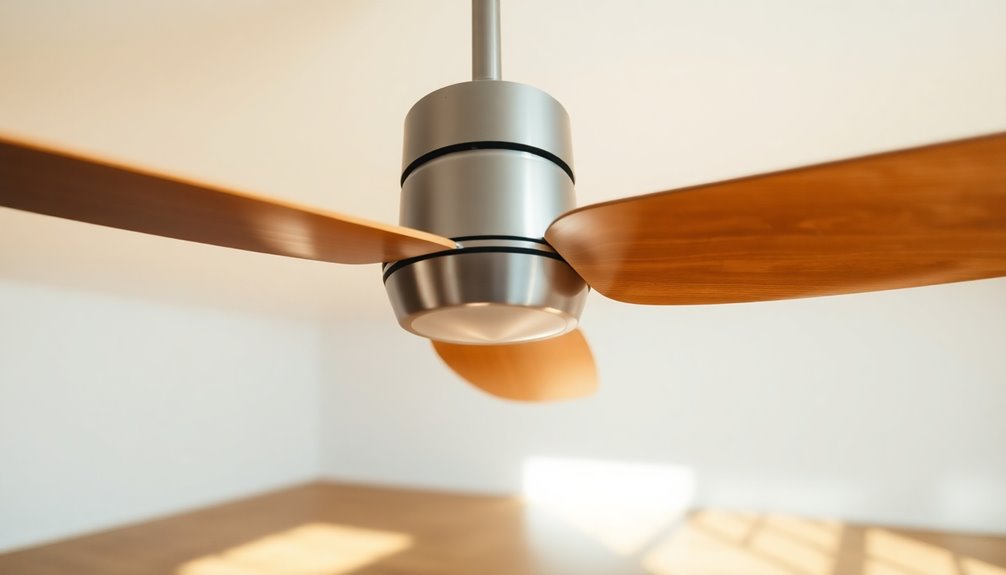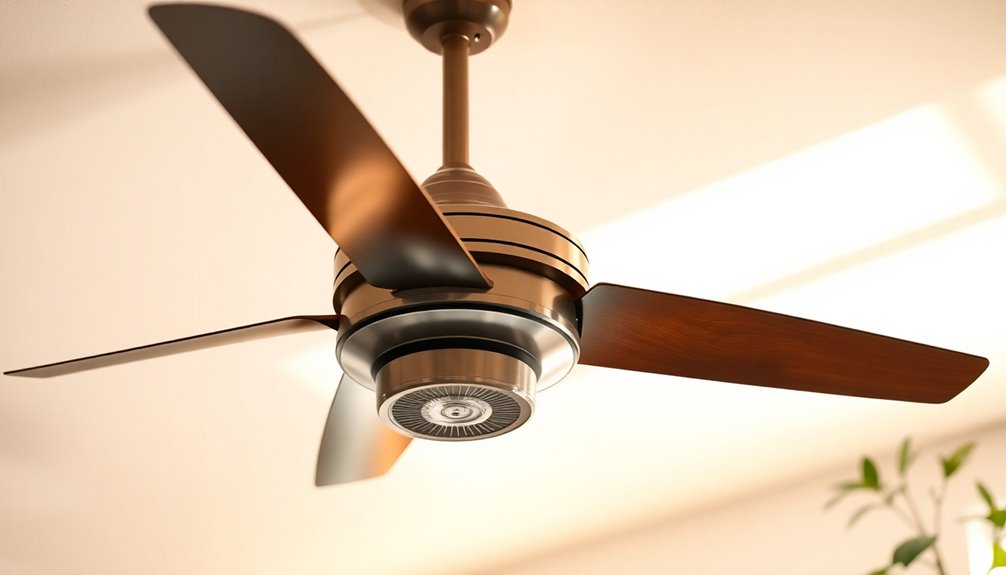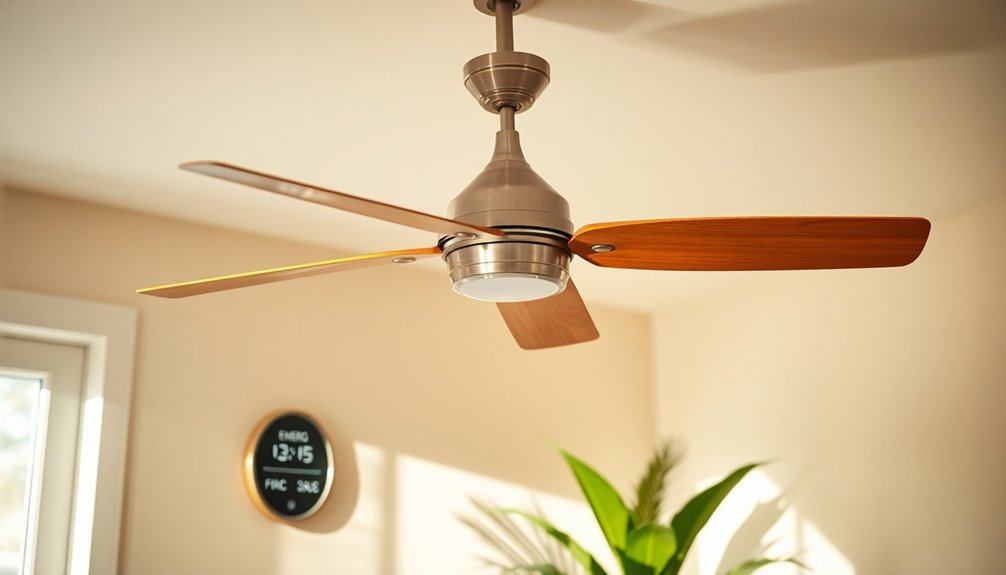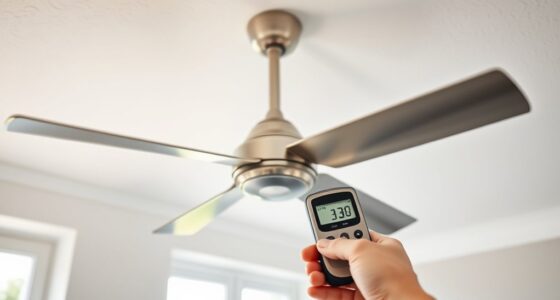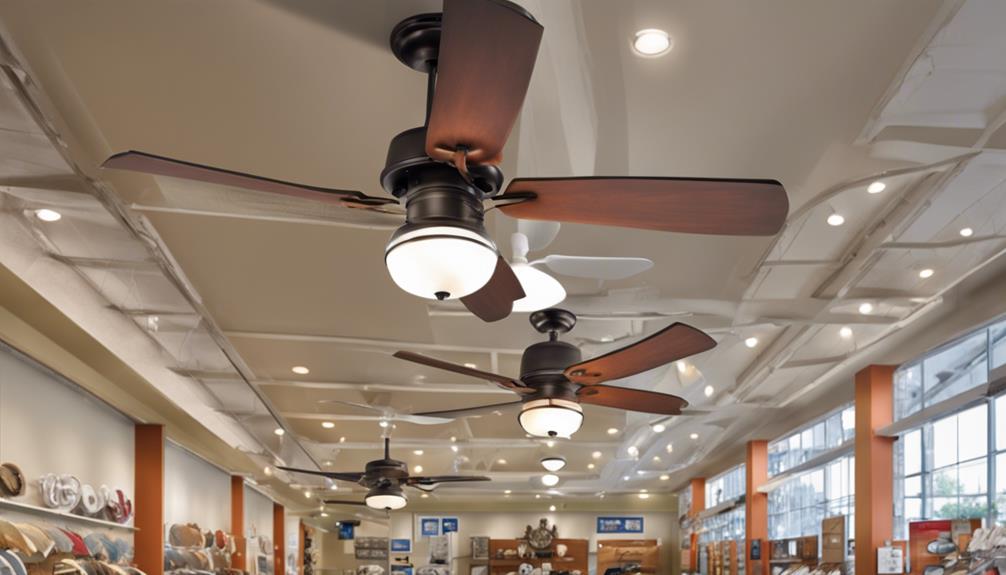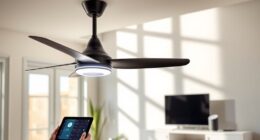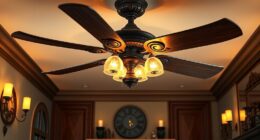Your ceiling fan should turn counterclockwise in the summer to create a cooling downdraft, making you feel cooler by up to 10°F. This setting allows you to raise your thermostat by as much as 4°F and cut cooling costs considerably. In the winter, switch it to clockwise to push warm air down and improve heat distribution. This adjustment can help save on heating expenses, too. Remember to make these changes every season for ideal comfort and energy efficiency. You'll discover even more tips for maintaining your fan and enhancing airflow.
Key Takeaways
- In summer, set your ceiling fan to rotate counterclockwise for a cooling downdraft effect.
- In winter, switch the fan to clockwise to distribute warm air evenly throughout the room.
- Adjust ceiling fan direction biannually during Daylight Savings Time for optimal comfort and efficiency.
- Use the pull chain, remote, or smart app to change the fan direction safely when it's turned off.
- Regularly maintaining your fan, including cleaning blades, enhances airflow and energy efficiency.
Importance of Ceiling Fan Direction

Understanding the importance of ceiling fan direction can greatly enhance your home comfort and energy efficiency.
Adjusting your ceiling fan rotation seasonally plays an essential role in maximizing air circulation and optimizing your heating and cooling systems. In summer, setting your fan to rotate counterclockwise creates a cooling downdraft, which allows you to raise your thermostat by up to 4 degrees without sacrificing comfort. This simple adjustment can considerably reduce energy costs during those hot months.
In winter, switching the fan to a clockwise rotation generates an updraft that helps distribute warm air more evenly throughout your space. This can lead to savings of up to 10% on your heating costs, as it allows your heating system to run more efficiently.
By regularly changing your fan direction according to the season, you can improve comfort levels and minimize reliance on your heating and cooling systems.
Ultimately, understanding and implementing the correct ceiling fan direction not only enhances your home's atmosphere but also promotes energy efficiency, making your living environment more enjoyable year-round.
Ceiling Fan Direction in Summer

In the sweltering heat of summer, adjusting your ceiling fan to rotate counterclockwise is a simple yet effective way to enhance your comfort. This ceiling fan direction creates a cooling downdraft that boosts airflow, making your space feel considerably cooler.
You'll experience a wind chill effect that can drop the perceived temperature by up to 10 degrees Fahrenheit, allowing you to enjoy an invigorating environment.
By using your ceiling fan in this manner, you can reduce your reliance on air conditioning, which may cut your cooling costs by up to 30%. To maximize this benefit, set your fan speed to high. This guarantees ideal air circulation, which is crucial for effective cooling during those sweltering summer days.
It's also essential to verify that your fan blades have a minimum angle of 12 degrees. This angle enhances airflow and cooling effectiveness, making your ceiling fan work harder for you.
Ceiling Fan Direction in Winter

In winter, you should set your ceiling fan to rotate clockwise.
This direction creates an updraft that helps push warm air down, making your space cozier while reducing heating costs.
Benefits of Clockwise Rotation
Setting your ceiling fan to rotate clockwise during winter can greatly enhance your home's heating efficiency. This ceiling fan direction creates an updraft that pulls cold air upwards, allowing warm air to be pushed down towards the floor.
This way, you'll enjoy more even heat distribution throughout your space, improving your overall comfort. Running your fan at low speed during clockwise rotation helps maintain a steady temperature while preventing unpleasant drafts that can occur at higher speeds.
By making this simple adjustment, you can reduce heating costs by up to 10%. It boosts heating efficiency and eases the burden on your heating system.
Most ceiling fans come with a fan switch conveniently located near the base, making it easy to change the direction for seasonal adjustments. Using your ceiling fan in conjunction with your heating system also promotes consistent thermostat settings.
This synergy can lead to a more comfortable atmosphere in your home during those chilly months. Embracing clockwise rotation not only creates a cozy environment but also proves to be an energy-efficient choice for your heating needs.
It's a smart way to maximize comfort while minimizing expenses.
Energy Savings in Winter
Changing your ceiling fan to rotate clockwise not only creates a cozy atmosphere but also leads to significant energy savings during the winter months.
By using the ceiling fan switch to change the direction, you can enhance heat distribution throughout your room. Running the fan at low speed allows for an updraft that pushes warm air trapped near the ceiling down into the living space, making your home feel warmer without cranking up the thermostat.
Here are some energy-saving benefits of using your ceiling fan in winter:
- Reduces heating costs by up to 10%
- Low power consumption, typically between 15 to 90 watts
- Maintains a consistent temperature, reducing reliance on heating systems
- Prevents drafts while enhancing comfort levels
Additionally, using a ceiling fan can complement your energy-efficient heat pumps, further optimizing your home's heating performance.
Changing Ceiling Fan Direction

To change your ceiling fan's direction, you'll want to adjust it based on the season: counterclockwise for cooling in the summer and clockwise for warming in the winter.
Depending on your fan type, you can use a pull chain, remote, or even a smart app to make the switch.
Once you've changed the direction, turn the fan back on to enjoy the benefits of proper airflow all year round. Additionally, proper use of ceiling fans can lead to lower energy bills by enhancing airflow and reducing reliance on air conditioning.
Seasonal Direction Adjustments
Adjust your ceiling fan direction with the seasons to maximize comfort and energy efficiency in your home.
During the summer months, you should set your fan to spin counterclockwise. This creates a cooling downdraft, enhancing comfort and reducing reliance on air conditioning.
In winter, flip the reversing switch to change the ceiling fan to spin clockwise at a low speed. This updraft redistributes warm air trapped near the ceiling, improving heating efficiency.
It's advisable to change the ceiling fan direction biannually, ideally during Daylight Savings Time adjustments in spring and fall, to match your seasonal temperature needs.
Regularly adjusting your fan can lead to significant energy savings:
- Up to 30% in cooling costs during summer
- Over 15% in heating costs during winter
- Improved comfort year-round
- Reduced strain on your HVAC system
To change the ceiling fan direction, always turn off the fan first, then use the reversing switch on the fan body or remote control, and turn the fan back on to test the new direction.
This simple adjustment can make a big difference in your home's comfort and energy efficiency!
Method for Direction Change
Understanding how to change your ceiling fan's direction can greatly enhance your comfort and energy savings. To start, always turn off the fan and wait for it to come to a complete stop before making any adjustments.
Most ceiling fans feature a reversing switch located on the motor housing. This switch allows you to toggle between counterclockwise for cold air circulation in the summer and clockwise for warm air redistribution in the winter.
If you have a remote-controlled fan, verify the remote is paired and then turn off the fan. Press and hold the fan button until you see a light blink, indicating the ceiling fan direction has successfully changed.
For those with smart ceiling fans, you can adjust the direction through compatible mobile apps or voice commands, making it even easier to manage your settings year-round.
After you've made the change, turn the fan back on to confirm it operates correctly in the new direction.
With the right adjustments, your ceiling fan can optimize your indoor climate efficiently, whether you need a cool breeze or a cozy warmth.
Benefits of Proper Direction
Properly changing your ceiling fan's direction can lead to substantial benefits in both comfort and energy efficiency. By adjusting the ceiling fan direction with the seasons, you can maximize airflow and enhance your living environment.
In the summer, using the counterclockwise rotation creates a cool breeze that allows you to feel comfortable and can reduce your reliance on air conditioning by up to 30%. Conversely, in winter, setting your fan to rotate clockwise at low speed helps circulate warm air from the ceiling, improving heat distribution and potentially lowering heating costs by up to 15%. Additionally, maintaining proper ventilation practices is essential for maximizing the effectiveness of your ceiling fan.
Here are some key benefits of proper ceiling fan direction:
- Enhanced comfort with improved temperature regulation
- Significant energy savings compared to air conditioning usage
- Consistent room temperatures for a more pleasant environment
- Reduced heating costs through efficient warm air circulation
- Additionally, when combined with energy-efficient technology, ceiling fans can further promote sustainable living practices and lower overall energy consumption.
Timing for Direction Change

Timing your ceiling fan's direction change is essential for maximizing comfort throughout the year. A great opportunity to change your ceiling fans comes with Daylight Savings Time adjustments.
In the spring, when you spring forward, set your fan to turn counterclockwise. This creates a cooling downdraft, enhancing air movement and making your space more comfortable during the warmer months.
Then, as fall arrives and you fall back, switch the direction to clockwise. This promotes the efficient circulation of warm air, ensuring your home stays cozy in the colder season.
Changing the fan direction seasonally not only boosts comfort but also contributes to energy savings. By adjusting your ceiling fan direction, you reduce the need for heating and cooling systems, which can lead to lower utility bills.
Regularly scheduled adjustments, like those made with the changing seasons, help maintain ideal airflow and temperature control in your living space.
Ceiling Fan Direction by Room

Choosing the right ceiling fan direction for each room can considerably enhance your comfort and energy efficiency.
Here's how to adjust your fans based on different spaces:
- Vaulted Ceilings: Keep your ceiling fan on counterclockwise year-round. This minimizes wind chill effects while maximizing airflow without creating drafts.
- Dining Rooms: Set the fan to rotate clockwise at medium or low speed. This prevents cooling food too quickly, maintaining a comfortable dining atmosphere.
- Home Offices: Use a medium clockwise setting to prevent papers and documents from blowing around, ensuring a focused working environment.
- Outdoor Fans: Position your fan to rotate counterclockwise at high speed. This enhances cooling effects and aids in insect control.
Energy Savings With Ceiling Fans

Ceiling fans can greatly reduce your energy bills when used effectively throughout the year.
During summer, setting your ceiling fan to rotate counterclockwise creates a cooling downdraft, helping you save up to 30% on cooling costs. This simple adjustment maximizes airflow efficiency, making it easier to regulate your indoor temperature without over-relying on air conditioning.
In winter, running your ceiling fan clockwise at a low speed redistributes warm air trapped near the ceiling, which can lead to heating bill reductions of 15% or more. By taking advantage of the ceiling fan direction, you can enhance your home's heating effectiveness.
Operating a ceiling fan consumes only about 50 watts, a fraction of what air conditioning units use, which can range from 3,500 to 4,500 watts.
For even greater energy savings, pair your ceiling fans with ENERGY STAR-certified air conditioning units. This combination can improve energy efficiency by up to 8%, optimizing your overall home cooling and heating performance. Additionally, investing in energy-efficient appliances can further enhance your energy savings while providing comfort year-round.
Optimal Blade Angle for Cooling

To maximize the cooling benefits of your ceiling fan, it's important to reflect on the blade angle. The ideal blade angle for ceiling fans should be a minimum of 12 degrees. This angle effectively creates airflow that enhances cooling efficiency.
However, be careful—angles above 16 degrees can disrupt loose objects in your room, so finding a balance is essential.
Here are some key points to take into account:
- Blade Angle: Aim for 12-16 degrees for ideal airflow.
- Air Movement: Proper angles help your fan move air effectively, creating cooler air during warmer months.
- Room Size: For larger spaces over 500 square feet, think about multiple ceiling fans to guarantee adequate airflow.
- Energy Savings: Efficient airflow allows you to set your thermostat higher, helping reduce energy costs.
General Ceiling Fan Maintenance Tips

Maintaining your ceiling fan is essential for guaranteeing peak performance and longevity. Start by regularly cleaning ceiling fan blades to remove dust and debris; this simple task can improve airflow and efficiency by up to 20%. While you're at it, don't forget to clean the motor as well.
Next, check that all screws and bolts are securely tightened. Loose components can cause wobbling and potential damage, affecting the fan's direction and overall function.
Use a leveling tool to inspect alignment; misaligned blades can lead to increased noise and reduced performance. To guarantee maximum airflow, maintain a minimum clearance of 10 inches between the blades and the ceiling, and 18 inches from walls. This space allows for better circulation and prevents the fan from straining.
Additionally, regularly inspect and replace any worn or damaged parts, such as pull chains or remote batteries, to keep the fan spinning smoothly. Following these maintenance tips won't only enhance the efficiency of your ceiling fan but also extend its lifespan, allowing you to enjoy cool breezes for years to come.
Frequently Asked Questions
How Do You Tell if a Fan Is Going Clockwise or Counterclockwise?
To tell if a fan's going clockwise or counterclockwise, stand directly underneath it.
If the blades seem to move from left to right and you feel a gentle updraft, it's rotating clockwise.
If you feel a strong breeze hitting your skin, it's counterclockwise, pushing air downwards.
You can also use lightweight paper; if it rises, the fan's going clockwise, and if it falls, it's spinning counterclockwise.
How Do I Know if My Ceiling Fan Is in Winter Mode?
Picture yourself cozying up in your living room, wrapped in a warm blanket.
To check if your ceiling fan's in winter mode, stand directly beneath it. If you feel little to no air movement, it's likely set correctly.
You can also look for the reversing switch on the fan body—flip it to change modes. If you have a remote or smart app, you can easily adjust it without getting up!
Which Way Should Ceiling Fans Turn in Summer?
In summer, you want your ceiling fan to create a revitalizing breeze.
Make sure it's rotating counterclockwise, which helps push cool air downwards. This motion enhances the wind chill effect, making you feel cooler without lowering the temperature.
You can stand underneath the fan and feel the airflow to confirm it's set correctly.
What Position Should the Switch Be on a Ceiling Fan?
Did you know that using a ceiling fan can save you up to 40% on energy costs during summer months?
To get the most out of your ceiling fan, make sure the switch is in the right position. If it's set to run counterclockwise, you'll enjoy a cooling breeze in the summer.
For winter warmth, flip the switch to clockwise. Always turn off the fan before changing the switch to protect the motor.
Conclusion
In the dance of seasons, your ceiling fan plays an essential role, just like a trusted partner. When summer's heat swells, it spins counterclockwise, creating a cool breeze that wraps around you like a revitalizing hug. As winter approaches, switch it to clockwise, gently circulating warm air, much like a cozy blanket embracing you on a chilly night. By mastering its direction, you're not just enhancing comfort; you're weaving energy savings into the fabric of your home.
